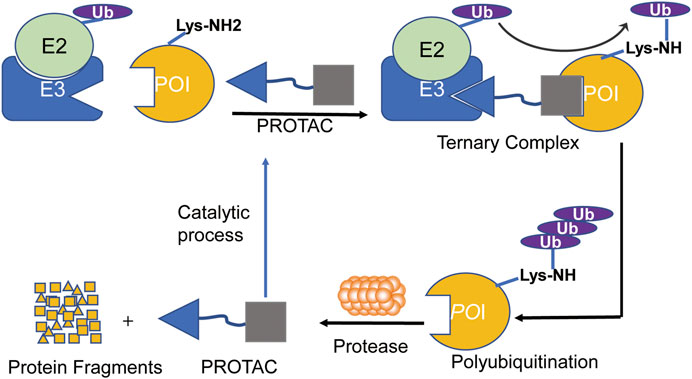The agents that break down proteins
In a recent article published in Nature Biotechnology, Ken Garber delves into the exciting world of molecular glue degraders, which are small molecules capable of removing undruggable proteins from cells. These molecular glue degraders work by hijacking the cell's disposal machinery to target and degrade disease-related proteins. The article highlights the potential of these compounds, especially in light of their cost-effectiveness compared to other therapies.
The article mentions Novartis biochemist Pamela Ting's presentation at the American Society of Hematology annual meeting, where she discussed the development of small-molecule protein degraders that target fetal hemoglobin. This work by Novartis showcases the growing interest in molecular glue degraders across the pharmaceutical industry. Companies like Bristol Myers Squibb and more than two dozen biotech firms are actively involved in research and development in this field.
However, the field of molecular protein degraders faces significant challenges. Screening for these compounds is a complex and time-consuming process, often conducted in cell-based assays due to the nature of protein-protein interactions. The rarity of successful hits in these screenings, coupled with the lack of understanding of the common chemical features of molecular glues, poses a high risk for researchers and companies in this space.
The article also explores the origins of molecular glues, citing examples like thalidomide and Revlimid, which have proven successful as molecular glue degraders targeting specific proteins. These successes have paved the way for the development of new compounds that can target a broader range of undruggable proteins, offering new possibilities for therapeutic interventions.
Different companies are employing various strategies to discover new molecular glue degraders. For example, Monte Rosa Therapeutics focuses on remodeling the surface of E3 ligases like cereblon to recruit a variety of proteins for degradation. Seed Therapeutics, on the other hand, emphasizes the selection of the right E3 ligase for targeting specific proteins, with a lengthy discovery process that involves high-throughput screening and medicinal chemistry.
The article also delves into the challenges of expanding the E3 ligase toolbox, as the field still lacks comprehensive knowledge of the hundreds of E3 ligases present in cells. Despite these challenges, companies like Plexium and A-Alpha Bio are exploring innovative approaches to identify and optimize protein-protein interactions, paving the way for the discovery of new molecular glue degraders.
In conclusion, while the field of molecular glue degraders holds immense promise for targeting undruggable proteins, it also faces significant hurdles that require innovative solutions. The ongoing research and development in this area are crucial for unlocking the full potential of molecular glue degraders in the treatment of various diseases.
Source: https://www.nature.com/articles/s41587-024-02164-9
Schematic diagram of ubiquitination process. The ubiquitin tag first binds to an E1 ubiquitin activating enzyme, transfers to an E2 ubiquitin binding enzyme, and then relies on an E3 ubiquitin ligase to deliver its ubiquitin to the target protein. Ubiquitin labeled proteins are specifically recognized and degraded by proteasome.
(https://www.frontiersin.org/journals/pharmacology/articles/10.3389/fphar.2021.692574/full)
(https://www.frontiersin.org/journals/pharmacology/articles/10.3389/fphar.2021.692574/full)
The article mentions Novartis biochemist Pamela Ting's presentation at the American Society of Hematology annual meeting, where she discussed the development of small-molecule protein degraders that target fetal hemoglobin. This work by Novartis showcases the growing interest in molecular glue degraders across the pharmaceutical industry. Companies like Bristol Myers Squibb and more than two dozen biotech firms are actively involved in research and development in this field.
However, the field of molecular protein degraders faces significant challenges. Screening for these compounds is a complex and time-consuming process, often conducted in cell-based assays due to the nature of protein-protein interactions. The rarity of successful hits in these screenings, coupled with the lack of understanding of the common chemical features of molecular glues, poses a high risk for researchers and companies in this space.
The process of PROTAC-mediated ubiquitination and proteasomal degradation of POI. PROTAC is composed of a ligand that binds to the E3 ubiquitin ligase and a ligand that binds to the target protein through a linker, which can induce the polyubiquitination and proteasome degradation of the target proteins in cells.
(https://www.frontiersin.org/journals/pharmacology/articles/10.3389/fphar.2021.692574/full)The article also explores the origins of molecular glues, citing examples like thalidomide and Revlimid, which have proven successful as molecular glue degraders targeting specific proteins. These successes have paved the way for the development of new compounds that can target a broader range of undruggable proteins, offering new possibilities for therapeutic interventions.
Different companies are employing various strategies to discover new molecular glue degraders. For example, Monte Rosa Therapeutics focuses on remodeling the surface of E3 ligases like cereblon to recruit a variety of proteins for degradation. Seed Therapeutics, on the other hand, emphasizes the selection of the right E3 ligase for targeting specific proteins, with a lengthy discovery process that involves high-throughput screening and medicinal chemistry.
The article also delves into the challenges of expanding the E3 ligase toolbox, as the field still lacks comprehensive knowledge of the hundreds of E3 ligases present in cells. Despite these challenges, companies like Plexium and A-Alpha Bio are exploring innovative approaches to identify and optimize protein-protein interactions, paving the way for the discovery of new molecular glue degraders.
In conclusion, while the field of molecular glue degraders holds immense promise for targeting undruggable proteins, it also faces significant hurdles that require innovative solutions. The ongoing research and development in this area are crucial for unlocking the full potential of molecular glue degraders in the treatment of various diseases.
Source: https://www.nature.com/articles/s41587-024-02164-9



Comments
Post a Comment